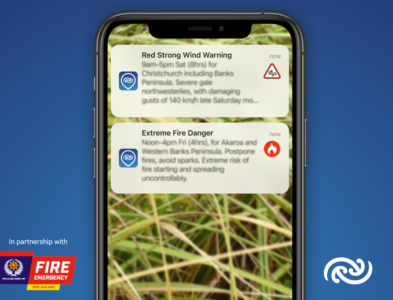
From today, January 25, Kiwis will be able to subscribe to receive notifications to their mobile phones when MetService issues a red warning for our most severe weather or if there is an extreme fire danger risk.
The partnership with Fire and Emergency New Zealand will help Kiwis be aware of and ready for the most extreme conditions. All that is required is to have the free MetService NZ Weather app installed on your mobile phone and the location specific notifications enabled.
MetService head of weather communication Lisa Murray says, “Getting notifications directly into the hands, or pockets, of those likely to be impacted is the most direct way we can warn people.”
Fire and Emergency wildfire specialist Rory Renwick concurs, “We encourage everyone to download the app, enable notifications and heed the advice when notifications are received. It may be best to postpone a fire or any activity which could cause sparks – always check further on checkitsalright.nz. It’s also a good prompt to prepare your property should a wildfire occur.
“The MetService app is a trusted source of information which close to a million people have downloaded to their phones. Weather conditions are one of the main factors that impact fire risk. This makes it the perfect place for our extreme fire danger notifications.”
Murray says with climate change and more extreme weather events, this tool will help prepare Kiwis for a more extreme wildfire and weather environment.
The location-specific push notification for extreme fire danger will be triggered when Fire and Emergency Fire Weather System calculates the fire danger to be at its highest level (extreme – where fire intensities and spread rates are likely to make a wildfire extremely dangerous). These are sent in the morning and provide that day’s timeframe for when fire danger is extreme and spark-causing activities, including lighting fires, should be avoided.
MetService will trigger notifications when red warnings for severe weather are issued for specific locations. These warnings are for the most significant and impactful heavy rain and/or strong winds (like those brought by ex-tropical cyclones) or heavy snow, covering an area of more than 1000 square kilometres (equivalent of a box around Lake Taupo).
Severe thunderstorm warnings are considered red warnings, though they cover a smaller and more localised area, their life-threatening impacts (flooding from downpours, hail and strong winds and lighting) make them very dangerous events.
“When a severe thunderstorm has been detected on one of our weather radars, a red warning notification will be triggered,” says Murray.
“Warning time is therefore much shorter than with other types of red warning weather, but a heads up will likely be signalled earlier in the day by a severe thunderstorm watch issued by our forecasters.”
The notifications have been some time in the making and follow a successful testing phase with members of the public to ensure ease of use and no false alerting. When people enable notifications, they’ll be prompted to set notifications for their home location and/or enable current location notifications which will provide alerts if they are in the warning area when a notification is issued.
“Fire danger awareness has become much stronger since we started running the fire season information on MetService’s website – notifications were a natural next step,” says Renwick.
Murray says, “It is close to a year since the devastating Auckland Anniversary flooding, followed closely by Cyclone Gabrielle. These notifications are one of the steps we’re taking to warn more Kiwis of dangerous weather.”









